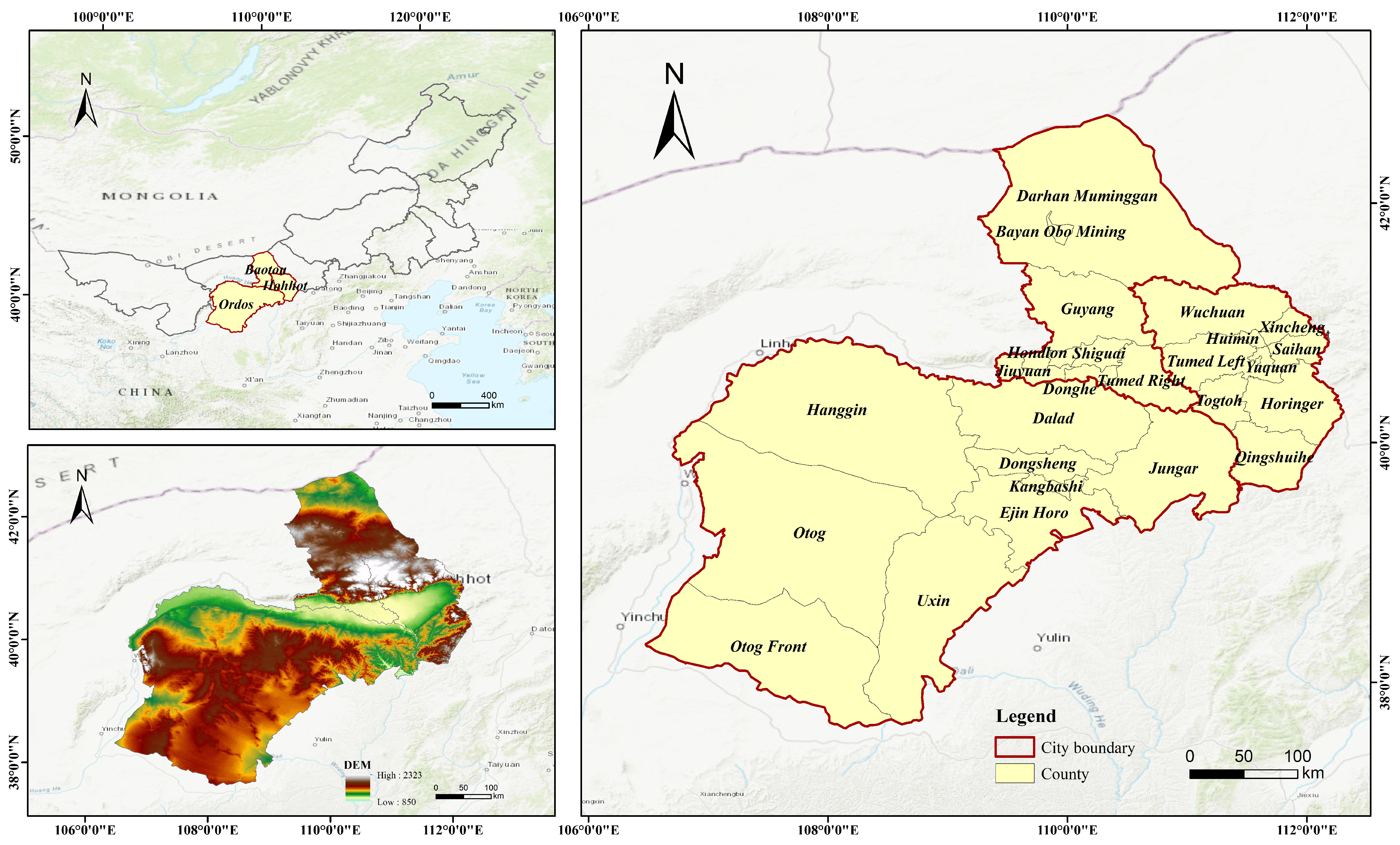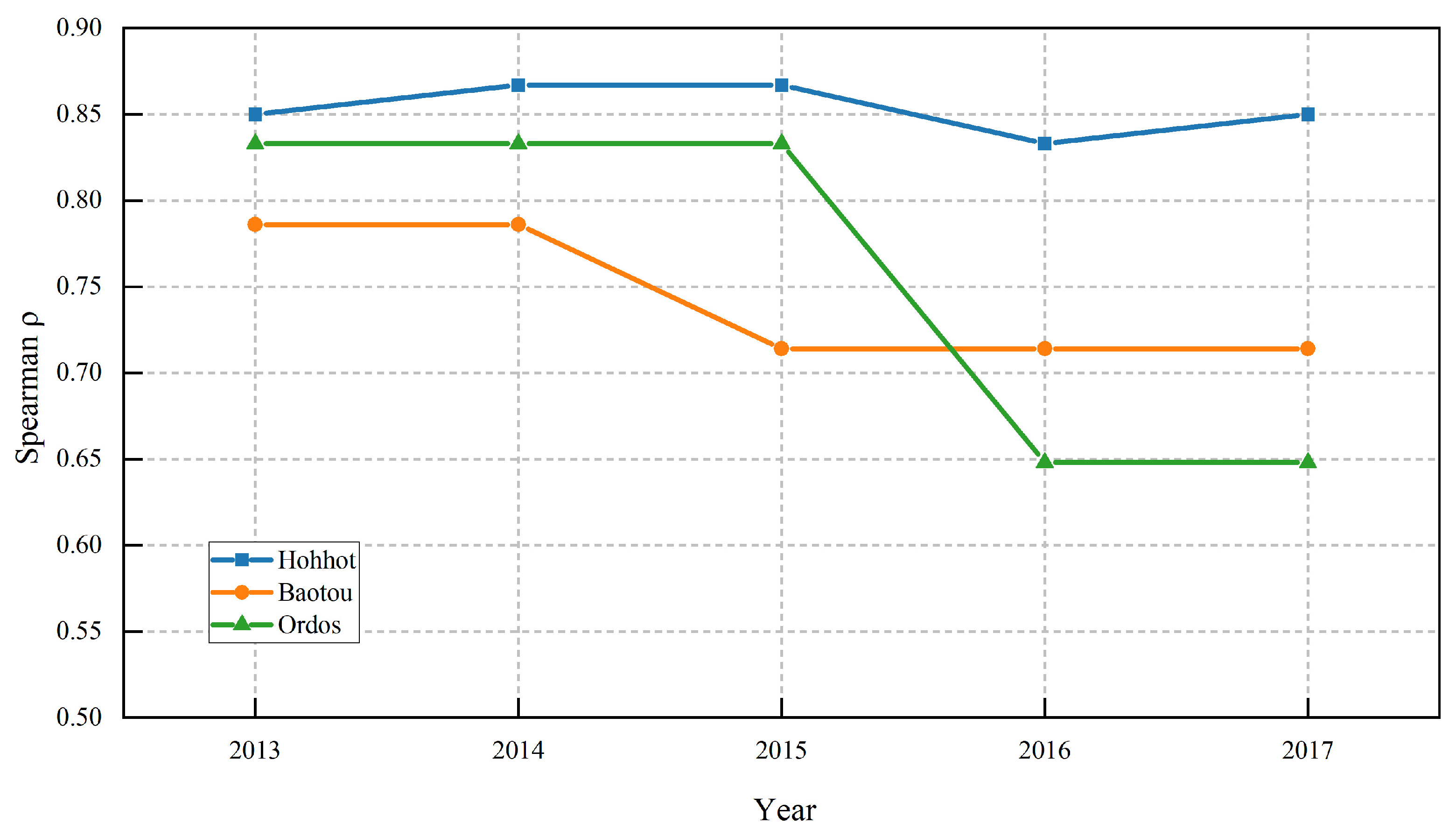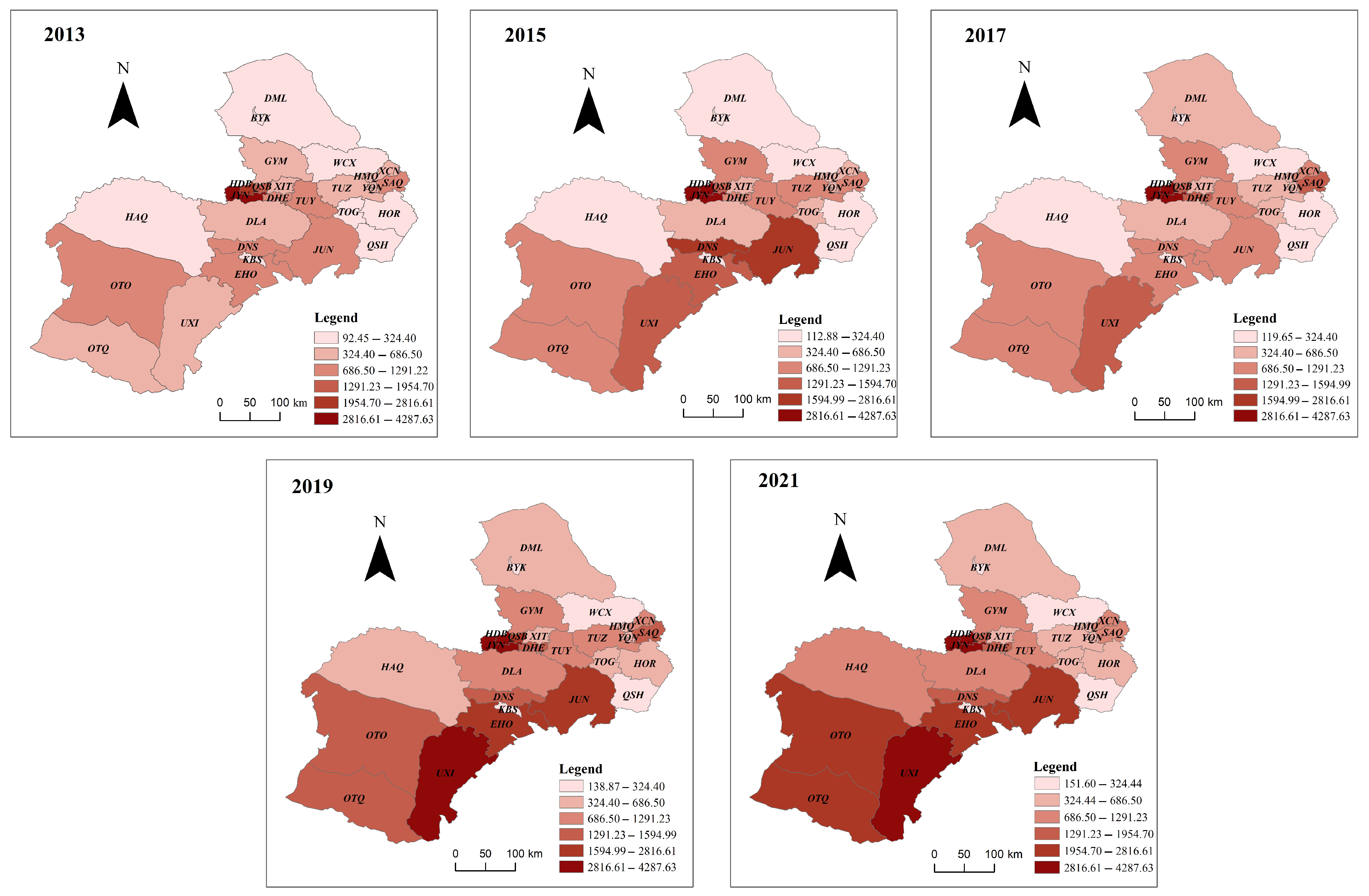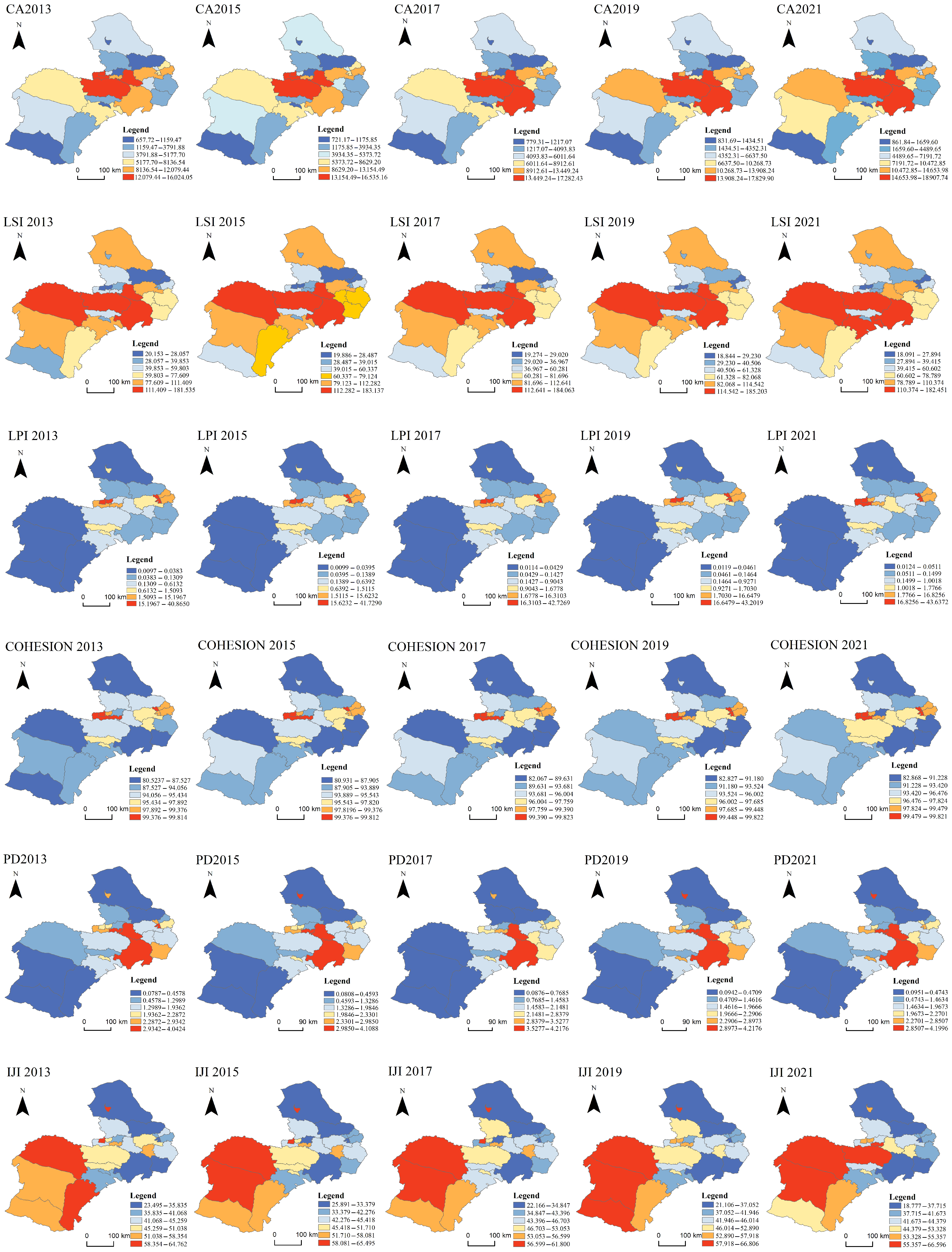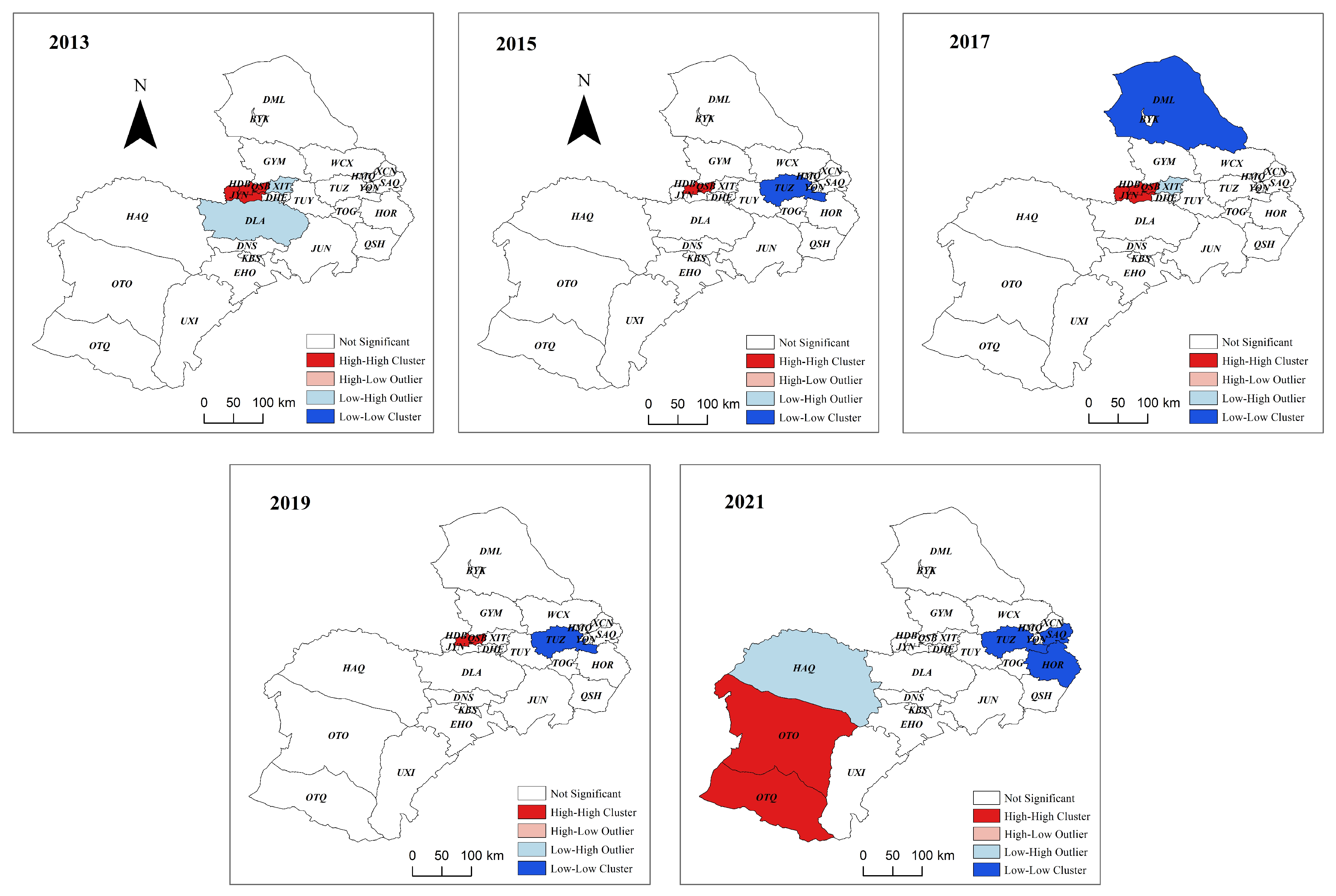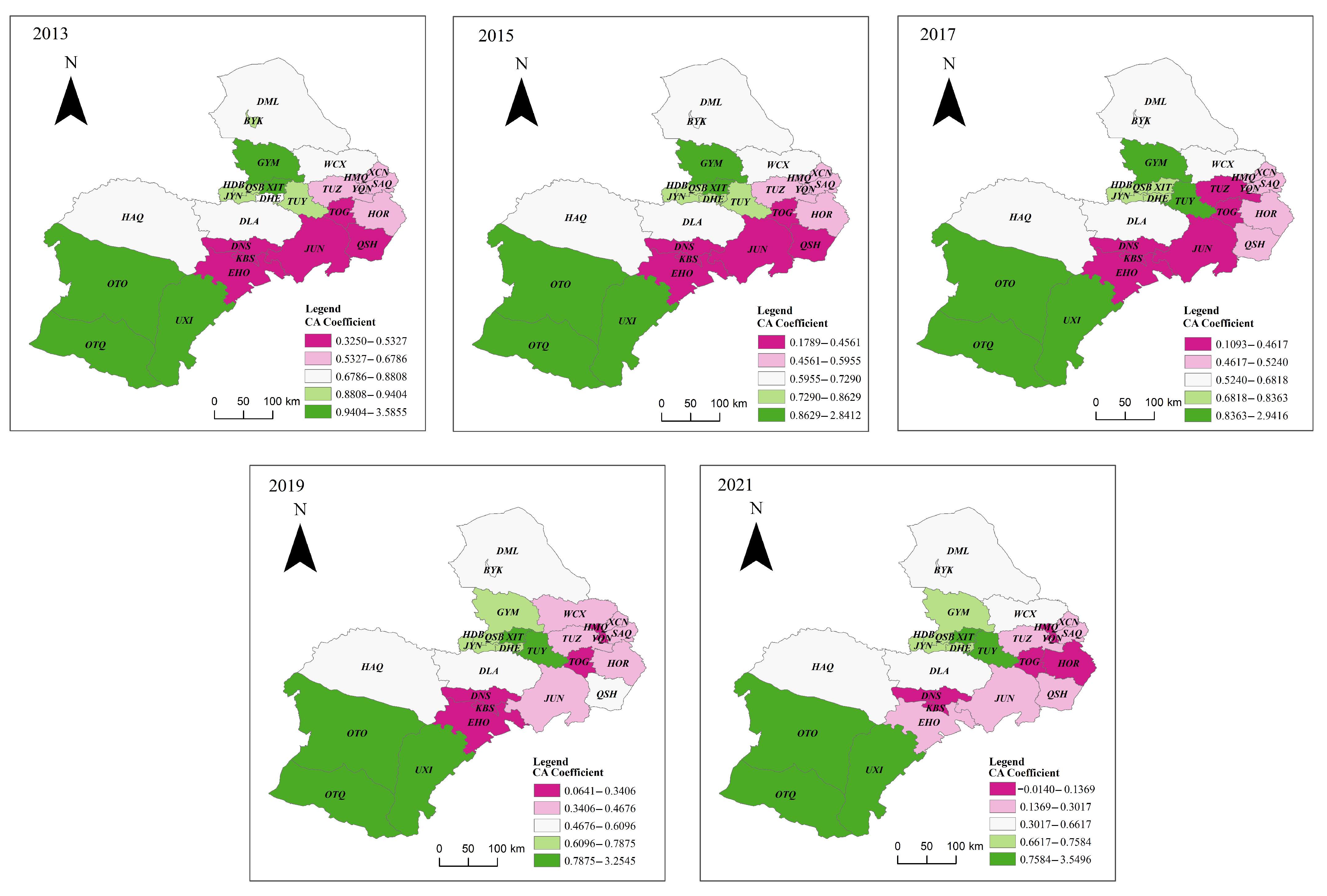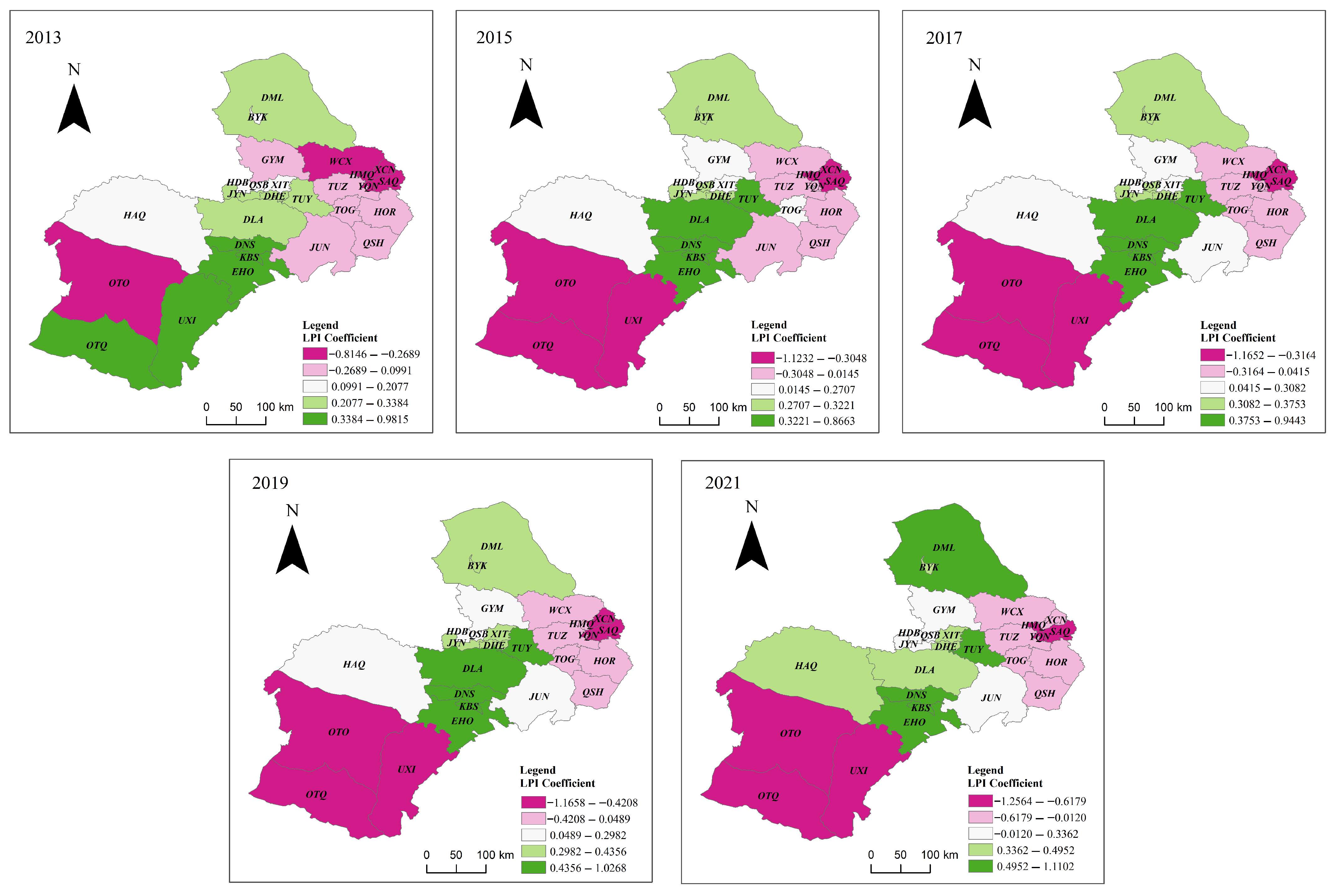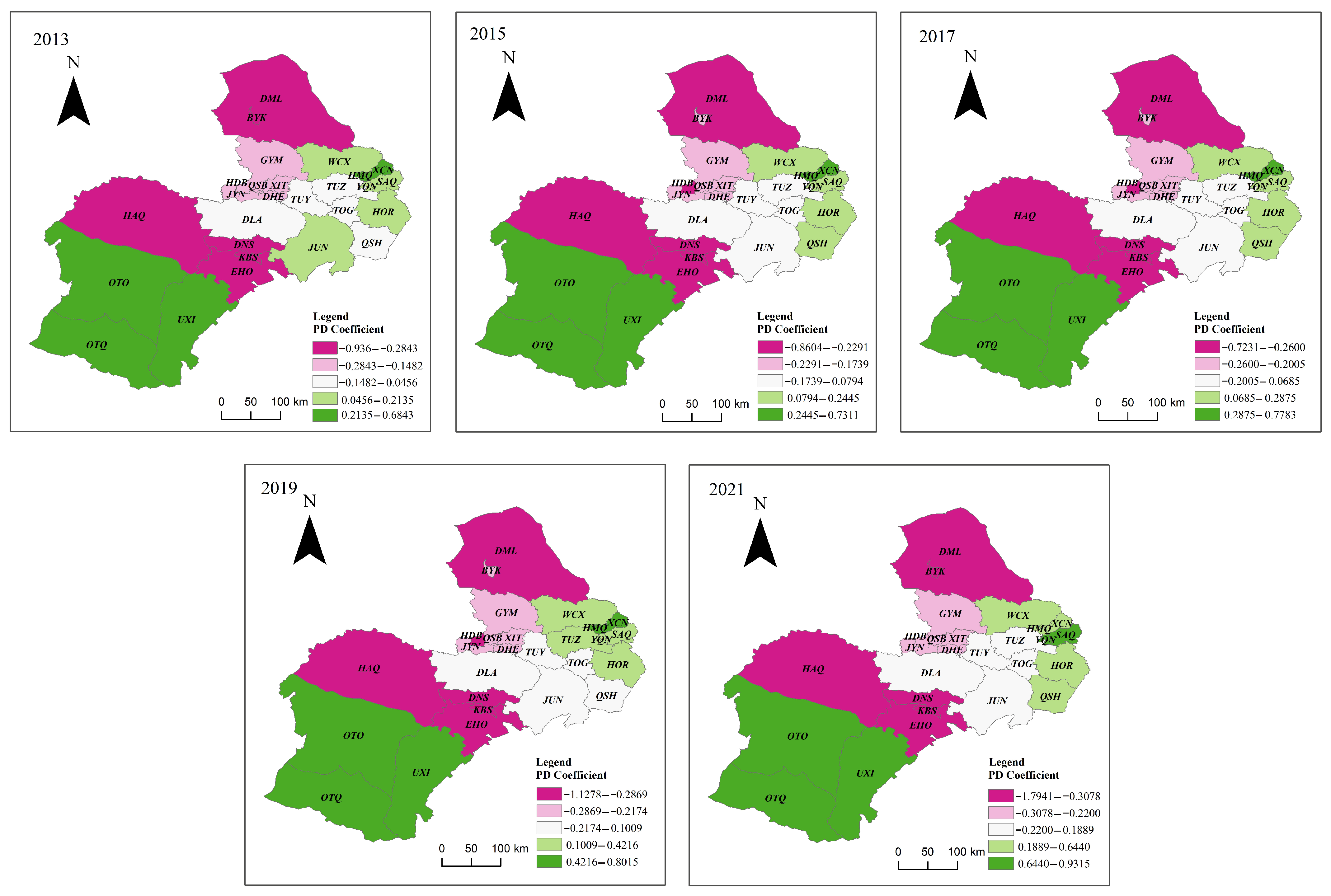4.3.1. Spatial Statistical Analysis
Based on analyses conducted using the ArcGIS platform, the Global Moran’s I values for 2013–2021 were obtained (
Table 4). The Global Moran’s I values for 2013, 2015, 2017, 2019, and 2021 were all greater than 0, with absolute Z-scores exceeding 1.96 and
p-values below 0.05, passing the significance test. These results indicate that carbon emissions in the HBO urban agglomeration exhibit a significant positive spatial autocorrelation, reflecting a clustered spatial pattern.
To further investigate the spatial association of carbon emissions within the HBO region, a local spatial autocorrelation analysis was conducted at the county scale.
Figure 8 presents the LISA clustering results of carbon emissions in the HBO urban agglomeration from 2013 to 2021.
High-emission areas exhibit significant H–H clustering, primarily concentrated in Baotou’s central urban districts, including industrial zones, and in Ordos’ energy extraction and processing areas. These regions are the core centers of energy, industry, and population within the urban agglomeration, resulting in high carbon emission intensity. From 2013 to 2019, these clusters were relatively stable in Hondlon, Qingshan, and Jiuyuan districts of Baotou, but by 2021 they had shifted from Baotou’s central districts to southwestern Ordos, specifically Otog Front Banner and Otog Banner. This indicates that high-emission zones exhibit strong spatial persistence, largely shaped by long-term industrial layouts and energy structures.
In contrast, L–L clusters are mainly distributed in Hohhot’s non-central areas and the northern parts of Baotou. These regions are characterized by weaker economic activity and limited industrial bases, leading to overall low carbon emission levels. Notably, between 2013 and 2021, the number of L–L clusters gradually increased, most of which were concentrated in Hohhot’s non-central areas. This suggests that previously less distinct clusters are undergoing industrial and energy restructuring, showing signs of emission reduction, and warranting further attention.
L–H clusters show a declining and intermittent trend: in 2013 they appeared in Dalad Banner (Ordos) and Shiguai District (Baotou); by 2017 only in Shiguai; and in 2021 they shifted to Hanggin Banner (Ordos). These results demonstrate pronounced spatial heterogeneity in the study region, with HBO’s carbon emissions showing hierarchical clustering overall, while the spatial clustering effects of individual counties are weakening. The dominant patterns are H–H and L–L clusters, with a few L–H anomalies, indicating strong spatial dependence of carbon emissions at the local scale.
4.3.4. Spatiotemporal Heterogeneity of Factors Influencing Carbon Emissions
Based on the regression results of the Geographically and Temporally Weighted Regression (GTWR) model, the spatial distribution of regression coefficients for six influencing factors in the years 2013, 2015, 2017, 2019, and 2021 was visualized using ArcGIS. This allows for an intuitive observation of the spatiotemporal variation in the effects of different factors on carbon emissions across the HBO, as shown in
Figure 9,
Figure 10,
Figure 11,
Figure 12,
Figure 13 and
Figure 14.
The spatiotemporal heterogeneity of the effect of the Urban Scale (CA) index on carbon emissions is shown in
Figure 9.
From a temporal perspective, the regression coefficients between the urban scale index (CA) and urban carbon emissions from 2013 to 2021 are positive and show an overall increasing trend. This suggests that urban expansion positively affects carbon emissions, and this effect has been growing stronger over time. As the built-up area expands, carbon emissions tend to increase.
Spatially, during the period 2013–2017, regions with high absolute values of CA regression coefficients were mainly concentrated in the central part of the study area, including Shiguai District and Guyang County, as well as in the southwestern areas such as Otog Banner, Otog Front Banner, and Uxin Banner. In contrast, low-value regions were located in the eastern part of Ordos and the southern part of Hohhot. Between 2017 and 2021, the regions with high absolute values of the CA regression coefficient gradually shifted from the central part of the study area to the southeastern region. Meanwhile, areas previously characterized by low values exhibited increasing coefficients, eventually resulting in a more scattered spatial distribution. The regression coefficients of CA show an alternating pattern of high and low values from the northeast to the southwest. The impact of urban expansion on carbon emissions is particularly pronounced in the southwestern part of the study area, with the most influential regions in the central zone gradually shifting toward the east.
The spatiotemporal heterogeneity of the effect of the Urban Complexity (LSI) index on carbon emissions is shown in
Figure 10.
From a temporal perspective, the regression coefficients between the urban complexity index (LSI) and urban carbon emissions from 2013 to 2021 are predominantly negative, indicating a generally negative correlation. This suggests that increases in urban complexity are associated with reductions in carbon emissions. The positive regression coefficients of LSI increased over time, while the negative coefficients decreased in magnitude. Overall, the distribution of regression coefficients exhibited a growing polarization trend over time.
Spatially, between 2013 and 2017, high LSI regression coefficient regions were primarily located in Kangbashi District, Dongsheng District, and Jungar Banner in Ordos City. Low-value regions were mainly distributed in the western part of the study area, including Otog Banner, Uxin Banner, and Otog Front Banner in Ordos City, as well as Hondlon District, Guyang County, and Shiguai District in Baotou City. Between 2017 and 2021, the spatial distribution of high-value LSI regions remained largely unchanged. However, in the southwestern part of the study area, Hanggin Banner emerged as a new low-value region. In the central area, the low-value zones shifted from Guyang County and Shiguai District to Hondlon District and Qingshan District.
The spatiotemporal heterogeneity of the effect of the Centrality (LPI) index on carbon emissions is shown in
Figure 11.
From a temporal perspective, the regression coefficients between the urban centrality index (LPI) and urban carbon emissions from 2013 to 2021 include both positive and negative values, with the extremes at both ends becoming increasingly polarized. This pattern reveals a clear trend of bipolarization, indicating that urban centrality exerts a significant bidirectional influence on carbon emissions.
Spatially, the regions with high LPI regression coefficients gradually shifted from the southwestern part of the study area to the central region. In 2013, high-value LPI regions were mainly concentrated in the southern part of Ordos, suggesting that increases in LPI in these areas were associated with higher carbon emissions. Conversely, low-value regions were located in Otog Banner (Ordos) and in the core urban areas of Xincheng District and Saihan District in Hohhot. Between 2015 and 2019, the high-value LPI regions shifted eastward to the eastern part of Ordos and the southeastern part of Baotou. In certain areas, such as Otog Front Banner and Uxin Banner, the regression coefficients changed from positive to negative, indicating a transition in their impact on carbon emissions from a positive to a negative effect. n 2021, regions with high LPI regression coefficients were distributed across northern Baotou (Darhan Muminggan United Banner), eastern Baotou (Tumed Right Banner), and eastern Ordos (Dongsheng District, Kangbashi District, and Ejin Horo Banner). Low-value regions were found in Otog Banner, Otog Front Banner, and Uxin Banner in Ordos, as well as in the Huimin, Yuquan, and Saihan districts of Hohhot.
The spatiotemporal heterogeneity of the effect of the Compactness (COHESION) index on carbon emissions is shown in
Figure 12.
From a temporal perspective, the regression coefficients between the urban compactness index (COHESION) and urban carbon emissions from 2013 to 2021 were predominantly positive, with their mean values gradually increasing. This indicates that urban compactness has had a mainly positive influence on carbon emissions over time. The number of regions where urban compactness exerts a positive effect on carbon emissions has increased over time. In areas with negative coefficients, the values have risen, indicating a gradual shift from a negative to a positive correlation. Meanwhile, in positively correlated regions, the coefficient values have also increased, suggesting a strengthening of the positive impact.
Spatially, between 2013 and 2021, low COHESION regression coefficients were primarily concentrated in the northeastern part of the study area, particularly in Darhan Muminggan United Banner and Wuchuan County, indicating that increased compactness in these regions was associated with reduced carbon emissions. High-value regions were mainly concentrated in the southwestern part of the study area, notably in Uxin Banner and Otog Banner of Ordos, suggesting that increases in COHESION in these areas were linked to rising carbon emissions. The regression coefficient for Ejin Horo Banner gradually declined, indicating a weakening of its positive influence. In contrast, Uxin Banner’s coefficient shifted from negative to positive, suggesting a reversal from a negative to a positive impact on carbon emissions.
The spatiotemporal heterogeneity of the effect of the Fragmentation (PD) index on carbon emissions is shown in
Figure 13.
From a temporal perspective, the regression coefficients between the urban fragmentation index (PD) and urban carbon emissions from 2013 to 2021 included both positive and negative values, indicating that urban fragmentation exerted a bidirectional influence on carbon emissions overall. The changes in regions with high and low regression coefficients are not significant.
Spatially, between 2013 and 2019, regions with high PD regression coefficients were mainly located in the southwestern part of the study area—specifically in Otog Banner, Otog Front Banner, and Uxin Banner—and in the eastern part, including Huimin District and Xincheng District of Hohhot. This indicates that PD exerts a positive impact on carbon emissions in these five regions; meanwhile, the low-value areas are mainly concentrated in Damao Banner in the north of the study area, as well as Hanggin, Dongsheng, Kangbashi, and Ejin Horo in the central part, suggesting that PD has a negative effect on carbon emissions in these regions. By 2021, the high PD regression coefficient regions in Hohhot had shifted from Huimin District and Xincheng District to Yuquan District and Saihan District. Overall, the distribution of low-value regions remained largely unchanged.
The spatiotemporal heterogeneity of the effect of the Land-Use Adjacency (IJI) index on carbon emissions is shown in
Figure 14.
From a temporal perspective, between 2013 and 2021, the regression coefficients between the land-use adjacency (IJI) and urban carbon emissions were predominantly negative, with only a small proportion being positive. This indicates that the IJI had a generally negative impact on urban carbon emissions. An increase in the IJI has an inhibitory effect on carbon emissions.
Spatially, from 2013 to 2017, regions with high IJI regression coefficients were located in the southwestern part of the study area (Otog Front Banner), the central part (Tumed Right Banner and Tumed Left Banner), and the northern part (Darhan Muminggan United Banner and Bayan Obo Mining District). Low-value regions were mainly distributed in the southern part of the study area, particularly in Dalad Banner and Dongsheng District. Between 2017 and 2021, there were significant shifts in both high- and low-value regions. In the central area, the high-value regions of Tumed Left and Right Banners shifted to Tumed Right Banner and Jungar Banner by 2019, and returned to Tumed Left and Right Banners by 2021. The low-value region shifted from Dalad Banner in 2017 to Hanggin Banner during the period from 2019 to 2021.
